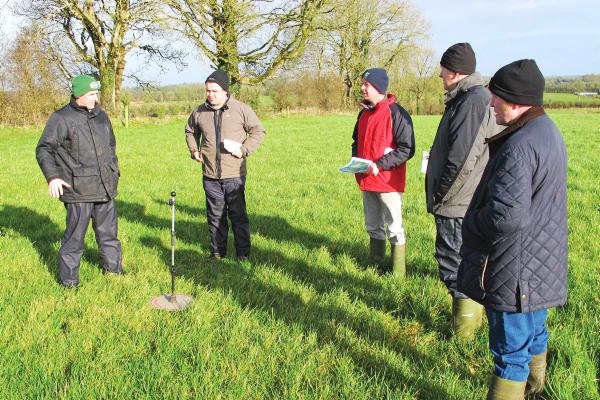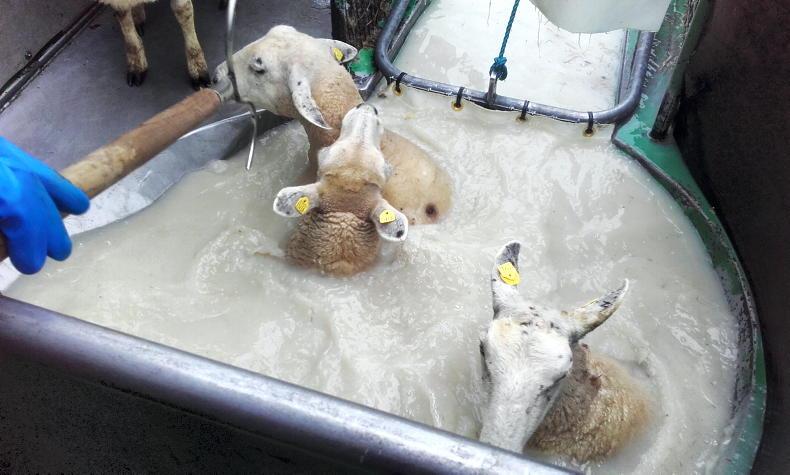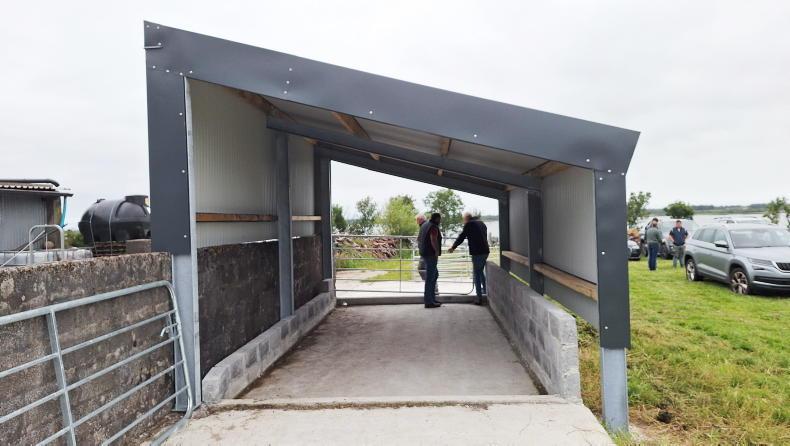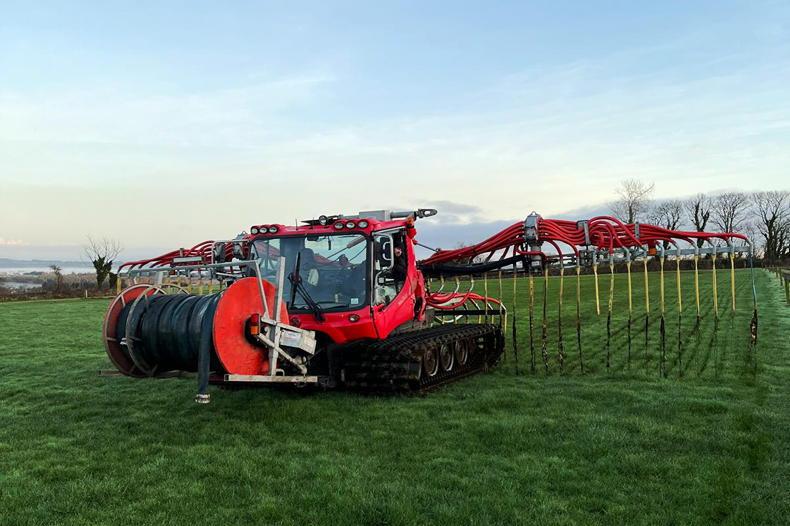The afternoon was held on Frank and Des Beirne’s farm at Newtownforbes, Co Longford. Discussion was facilitated by programme adviser Adam Woods, ably assisted by local beef adviser, James Keane.
Items covered on the day included:
An overview of the farm and the progress being made to date.Early grazing management.Stock performance.Similar to last week, many farmers consider it too early in the year to be talking about grassland management given that most land is saturated. But as highlighted by both advisers, whether you go out to grass in early February or mid March, if you get the first grazing wrong you will be in trouble for the rest of the year.
Cost benefit of spring grazing
Take a 380kg store weanling in the shed over March being fed 25kg of silage (€35/tonne) and 2kg of a low cost barley, distillers and beet pulp ration (€290/tonne). Daily feed cost is €1.46 per day for each weanling. Given that most silage quality is in the range of 62-66 DMD around the country, the animal is most likely gaining at best 0.5kg of liveweight per day.
This means at a price of €2.20/kg in the live ring, the animal is generating €1.10 of income per day in the shed. The cost of keeping the weanling housed is costing €0.36 per day over what the animal is actually making
Due to silage quality, it is unlikely that these animals will be over fat. They will most likely be in prime body condition, with plenty of frame developed over winter, to thrive on at grass. If a small group of around ten or twelve animals are let back out to graze as soon as ground is dry enough to take them, these animals should respond with compensatory growth. Roughly speaking, it costs €1.20 per kg of nitrogen from CAN at present which is capable of growing about 25-35kg of dry matter if spread in good conditions. A 380kg weanling will eat approximately 2% of its body weight each day in dry matter. Therefore, it would cost €0.30 per day to graze that weanling over March.
Add in the performance benefit from compensatory growth would see the animal daily gains of 1.1 to 1.5kg/day. Some bull weanlings will be capable of higher gains for a period of one month. Taking an average daily liveweight gain of 1.2kg/day, means that the animal would be generating a daily income of €2.64. Including the feed cost would leave a daily margin of €2.34 per day. Over the month of March there is potential to save €431 in feed costs for a group of 12 weanlings that get back to grass at the beginning of the month compared with being housed to the end of the month.
Using the spring rotation planner
There is often a policy on farms to not let cattle back to grass until the silage is gone, usually in mid-April. However, this is unlikely to be the case this year as most farms are short of silage. Even if your ground is naturally heavy, it should still be able to hold a few weanlings in mid to late March. Participants in the programme are now focussing their attention on the spring rotation by putting priority stock back to grass first.
If you have to put a few cattle back out, it should be the lightest cattle and stock them at a low rate of 500-600kg/acre to begin the year with.
How well you manage the grass in the first grazing will determine how much grass you will grow in the remainder of the season. If you get it wrong and land gets damaged, then it will take longer for regrowth to come. Taking steps now should see that land is properly managed to avoid potential problems.
The spring rotation planner is a simple plan that sets out the farm into weekly grazing plots. The only information that is required by the farmer is a target turnout date for the first stock, the date you want to begin the second rotation and when you expect grass growth to match stock demand, ie the magic day.
As suggested by its name, the rotation planner is merely a plan for you to follow. It will not tell you daily growth rates, but if you set out to have a certain area of land grazed off in the first week, it will let you see if you are on target or not.
You will be required to walk the paddocks weekly to see how growth is coming along. Walking paddocks should become part of your weekly management now. Why should you care about what other farmers think if you are using a plate meter weekly.
It is your farm and you generate the profit inside the gate. As shown from the cost benefit of grazing, grass can no longer be ignored. It is the cheapest feed you will produce so every effort should be made to keep grazing quality as high as possible.
The rotation planner will ensure that there is sufficient grass grazed to allow time for enough regrowth to start the second rotation. It will also ensure that grass does not run out before the start of the second rotation. Due to wetter conditions, turnout would be delayed for most farms so this year, a dry farm should:
Turn out light weanlings from mid February to early March.
Target 40% of the grazing area, which includes the silage ground, to be grazed off by the 20-25 March.
60% of the farm should be grazed off by 5 April.
100% of the farm grazed by 20 April.
A wet farm should target:
Turn out of light weanlings only by 15-20 March.
Target 40% of the farm, including silage are, grazed off by 5 April.
Target 60% of the farm should be grazed by 20 April.
100% of the farm grazed by 1 May.
If weather improves and spring turns out to be dry, the guideline figures can be altered.
Table 1 shows how the rotation planner works. The farmer enters the date in the relevant column, the number of acres he hopes to graze each week and the actual number grazed.
The first rotation should last approximately eight weeks to allow gradual turnout of stock and inclusion of silage ground in the grazing area.
Managing the first rotation
The programme farmers saw how Frank and Des Beirne had closed land up in rotation for spring turnout. Despite being in north Longford, they are prepared to let weanling bulls back to graze as within the next week if weather permits.
Des has measured the farm and has 44 grazing days ahead for a group of 34 bulls that will be grazed in 1ha paddocks. Watery slurry was applied with a pipeline in autumn and January, and younger swards have responded with growth. The farm has covers of 2,500kgDM/ha at present. Bulls will be grazed in two day or three day paddocks and which will then be dressed with slurry and or urea after grazing.
Key points
Be flexible with turnout date and phase cattle out slowly.Introduce light cattle for a few hours at the beginning to avoid poor utilisation.Gradually increase stock numbers as grass growth picks up.Do not mix bulls though.Graze strongest covers first or reseeded ground as it will have a faster regrowth.Move cattle on to the next paddock if the weather is unsettled. Do not be afraid to re-house during pro-longed bad weather.Maximise slurry potential in early spring.
The afternoon was held on Frank and Des Beirne’s farm at Newtownforbes, Co Longford. Discussion was facilitated by programme adviser Adam Woods, ably assisted by local beef adviser, James Keane.
Items covered on the day included:
An overview of the farm and the progress being made to date.Early grazing management.Stock performance.Similar to last week, many farmers consider it too early in the year to be talking about grassland management given that most land is saturated. But as highlighted by both advisers, whether you go out to grass in early February or mid March, if you get the first grazing wrong you will be in trouble for the rest of the year.
Cost benefit of spring grazing
Take a 380kg store weanling in the shed over March being fed 25kg of silage (€35/tonne) and 2kg of a low cost barley, distillers and beet pulp ration (€290/tonne). Daily feed cost is €1.46 per day for each weanling. Given that most silage quality is in the range of 62-66 DMD around the country, the animal is most likely gaining at best 0.5kg of liveweight per day.
This means at a price of €2.20/kg in the live ring, the animal is generating €1.10 of income per day in the shed. The cost of keeping the weanling housed is costing €0.36 per day over what the animal is actually making
Due to silage quality, it is unlikely that these animals will be over fat. They will most likely be in prime body condition, with plenty of frame developed over winter, to thrive on at grass. If a small group of around ten or twelve animals are let back out to graze as soon as ground is dry enough to take them, these animals should respond with compensatory growth. Roughly speaking, it costs €1.20 per kg of nitrogen from CAN at present which is capable of growing about 25-35kg of dry matter if spread in good conditions. A 380kg weanling will eat approximately 2% of its body weight each day in dry matter. Therefore, it would cost €0.30 per day to graze that weanling over March.
Add in the performance benefit from compensatory growth would see the animal daily gains of 1.1 to 1.5kg/day. Some bull weanlings will be capable of higher gains for a period of one month. Taking an average daily liveweight gain of 1.2kg/day, means that the animal would be generating a daily income of €2.64. Including the feed cost would leave a daily margin of €2.34 per day. Over the month of March there is potential to save €431 in feed costs for a group of 12 weanlings that get back to grass at the beginning of the month compared with being housed to the end of the month.
Using the spring rotation planner
There is often a policy on farms to not let cattle back to grass until the silage is gone, usually in mid-April. However, this is unlikely to be the case this year as most farms are short of silage. Even if your ground is naturally heavy, it should still be able to hold a few weanlings in mid to late March. Participants in the programme are now focussing their attention on the spring rotation by putting priority stock back to grass first.
If you have to put a few cattle back out, it should be the lightest cattle and stock them at a low rate of 500-600kg/acre to begin the year with.
How well you manage the grass in the first grazing will determine how much grass you will grow in the remainder of the season. If you get it wrong and land gets damaged, then it will take longer for regrowth to come. Taking steps now should see that land is properly managed to avoid potential problems.
The spring rotation planner is a simple plan that sets out the farm into weekly grazing plots. The only information that is required by the farmer is a target turnout date for the first stock, the date you want to begin the second rotation and when you expect grass growth to match stock demand, ie the magic day.
As suggested by its name, the rotation planner is merely a plan for you to follow. It will not tell you daily growth rates, but if you set out to have a certain area of land grazed off in the first week, it will let you see if you are on target or not.
You will be required to walk the paddocks weekly to see how growth is coming along. Walking paddocks should become part of your weekly management now. Why should you care about what other farmers think if you are using a plate meter weekly.
It is your farm and you generate the profit inside the gate. As shown from the cost benefit of grazing, grass can no longer be ignored. It is the cheapest feed you will produce so every effort should be made to keep grazing quality as high as possible.
The rotation planner will ensure that there is sufficient grass grazed to allow time for enough regrowth to start the second rotation. It will also ensure that grass does not run out before the start of the second rotation. Due to wetter conditions, turnout would be delayed for most farms so this year, a dry farm should:
Turn out light weanlings from mid February to early March.
Target 40% of the grazing area, which includes the silage ground, to be grazed off by the 20-25 March.
60% of the farm should be grazed off by 5 April.
100% of the farm grazed by 20 April.
A wet farm should target:
Turn out of light weanlings only by 15-20 March.
Target 40% of the farm, including silage are, grazed off by 5 April.
Target 60% of the farm should be grazed by 20 April.
100% of the farm grazed by 1 May.
If weather improves and spring turns out to be dry, the guideline figures can be altered.
Table 1 shows how the rotation planner works. The farmer enters the date in the relevant column, the number of acres he hopes to graze each week and the actual number grazed.
The first rotation should last approximately eight weeks to allow gradual turnout of stock and inclusion of silage ground in the grazing area.
Managing the first rotation
The programme farmers saw how Frank and Des Beirne had closed land up in rotation for spring turnout. Despite being in north Longford, they are prepared to let weanling bulls back to graze as within the next week if weather permits.
Des has measured the farm and has 44 grazing days ahead for a group of 34 bulls that will be grazed in 1ha paddocks. Watery slurry was applied with a pipeline in autumn and January, and younger swards have responded with growth. The farm has covers of 2,500kgDM/ha at present. Bulls will be grazed in two day or three day paddocks and which will then be dressed with slurry and or urea after grazing.
Key points
Be flexible with turnout date and phase cattle out slowly.Introduce light cattle for a few hours at the beginning to avoid poor utilisation.Gradually increase stock numbers as grass growth picks up.Do not mix bulls though.Graze strongest covers first or reseeded ground as it will have a faster regrowth.Move cattle on to the next paddock if the weather is unsettled. Do not be afraid to re-house during pro-longed bad weather.Maximise slurry potential in early spring. 










SHARING OPTIONS